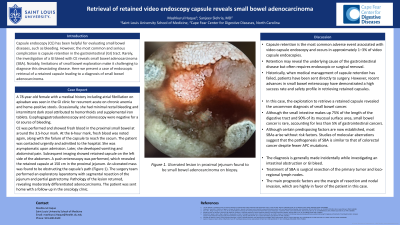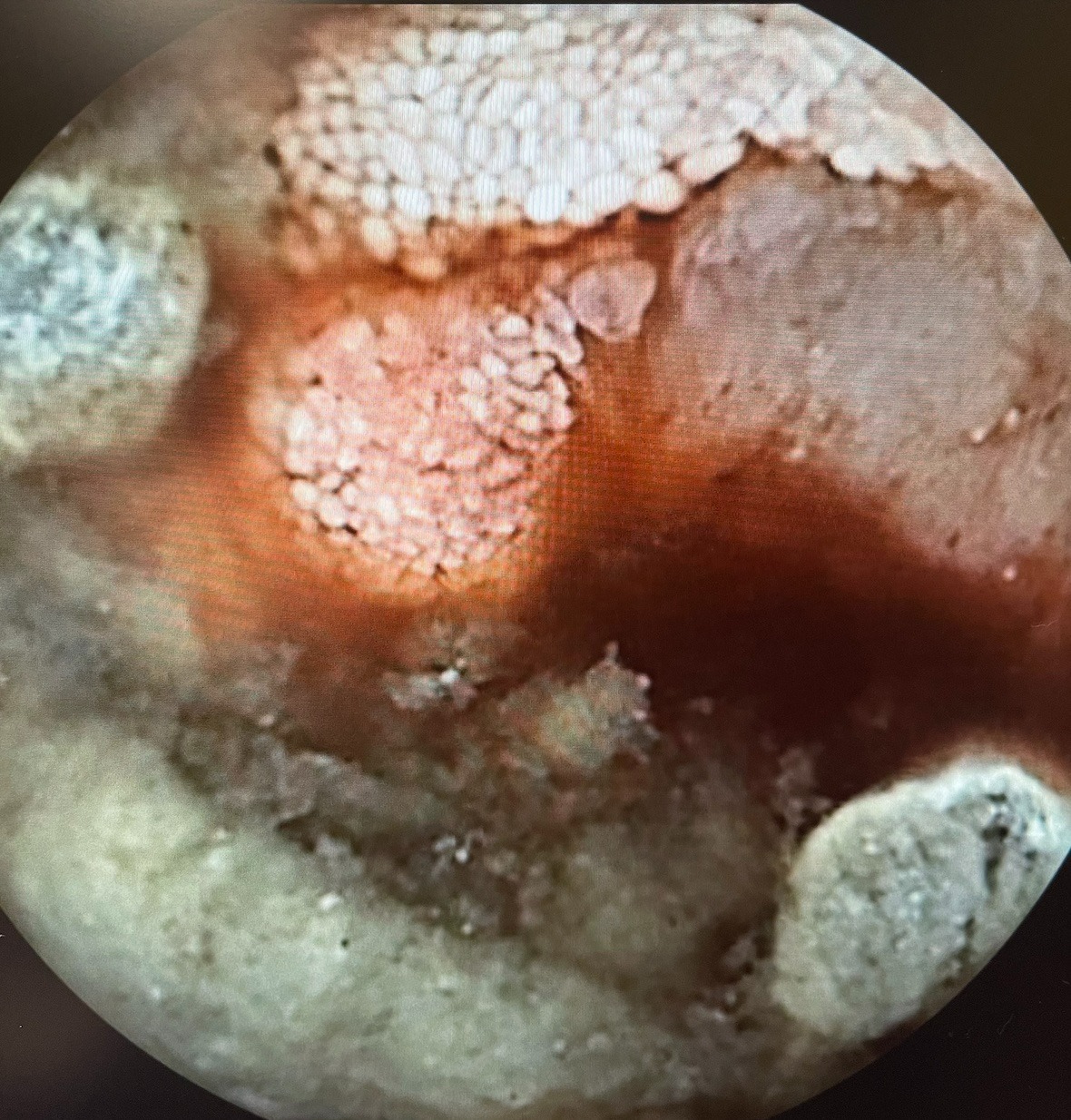Back


Poster Session A - Sunday Afternoon
Category: Small Intestine
A0658 - Retrieval of Retained Video Endoscopy Capsule Reveals Small Bowel Adenocarcinoma
Sunday, October 23, 2022
5:00 PM – 7:00 PM ET
Location: Crown Ballroom

Has Audio

Mashkurul Haque
Saint Louis University
St. Louis, MO
Presenting Author(s)
Mashkurul Haque, 1, Sanjeev Slehria, MD2
1Saint Louis University, St. Louis, MO; 2Cape Fear Center for Digestive Diseases, Fayetteville, NC
Introduction: Capsule endoscopy (CE) has been useful for evaluating diseases of the small bowel, such as bleeding. However, the most common and serious complication is capsule retention in the gastrointestinal (GI) tract. Rarely, the investigation of a GI bleed with CE reveals small bowel adenocarcinoma (SBA). Notably, limitations of small bowel exploration make it difficult to diagnose this devastating disease. Here we present a case of endoscopic retrieval of a retained capsule leading to a diagnosis of small bowel adenocarcinoma.
Case Description/Methods: A 78-year-old female with medical history including atrial fibrillation on apixaban was seen in the GI clinic for recurrent acute on chronic anemia and heme positive stools. Occasionally, she had minimal rectal bleeding and intermittent dark stool attributed to hemorrhoids and supplemental iron tablets. Esophagogastroduodenoscopy and colonoscopy were negative for a GI source of bleeding.
CE was performed and showed fresh blood in the proximal small bowel at around the 3.5-hour mark. At the 6-hour mark, fresh blood was noted again along with failure of capsule to reach the cecum. Patient was contacted urgently and admitted to the hospital. She was asymptomatic upon admission. Later, she developed vomiting and abdominal pain. Subsequent imaging showed retained capsule in left side of abdomen. A push enteroscopy was performed which revealed the retained capsule at 150 cm in the proximal jejunum. An ulcerated mass was found to be obstructing the capsules path (Figure 1). Surgery performed an exploratory laparotomy with segmental resection of jejunum and partial gastrectomy. Pathology of the lesion returned with moderately differentiated adenocarcinoma. Patient was sent home with follow up in oncology clinic.
Discussion: Capsule retention occurs in approximately 1–3% of video capsule endoscopies. Retention often requires endoscopic or surgical removal. In this case, the exploration to retrieve a retained capsule revealed the uncommon diagnosis of small bowel cancer. Of the GI tumors, less than 6% are found to be SBA. SBAs typically occur without identifying risk factors. The diagnosis is typically made incidentally while investigating an intestinal obstruction or GI bleed. Treatment of SBA is surgical resection of the primary tumor and loco-regional lymph nodes. The main prognostic factors are margin of resection and nodal invasion, which are highly in favor of the patient in this case.

Disclosures:
Mashkurul Haque, 1, Sanjeev Slehria, MD2. A0658 - Retrieval of Retained Video Endoscopy Capsule Reveals Small Bowel Adenocarcinoma, ACG 2022 Annual Scientific Meeting Abstracts. Charlotte, NC: American College of Gastroenterology.
1Saint Louis University, St. Louis, MO; 2Cape Fear Center for Digestive Diseases, Fayetteville, NC
Introduction: Capsule endoscopy (CE) has been useful for evaluating diseases of the small bowel, such as bleeding. However, the most common and serious complication is capsule retention in the gastrointestinal (GI) tract. Rarely, the investigation of a GI bleed with CE reveals small bowel adenocarcinoma (SBA). Notably, limitations of small bowel exploration make it difficult to diagnose this devastating disease. Here we present a case of endoscopic retrieval of a retained capsule leading to a diagnosis of small bowel adenocarcinoma.
Case Description/Methods: A 78-year-old female with medical history including atrial fibrillation on apixaban was seen in the GI clinic for recurrent acute on chronic anemia and heme positive stools. Occasionally, she had minimal rectal bleeding and intermittent dark stool attributed to hemorrhoids and supplemental iron tablets. Esophagogastroduodenoscopy and colonoscopy were negative for a GI source of bleeding.
CE was performed and showed fresh blood in the proximal small bowel at around the 3.5-hour mark. At the 6-hour mark, fresh blood was noted again along with failure of capsule to reach the cecum. Patient was contacted urgently and admitted to the hospital. She was asymptomatic upon admission. Later, she developed vomiting and abdominal pain. Subsequent imaging showed retained capsule in left side of abdomen. A push enteroscopy was performed which revealed the retained capsule at 150 cm in the proximal jejunum. An ulcerated mass was found to be obstructing the capsules path (Figure 1). Surgery performed an exploratory laparotomy with segmental resection of jejunum and partial gastrectomy. Pathology of the lesion returned with moderately differentiated adenocarcinoma. Patient was sent home with follow up in oncology clinic.
Discussion: Capsule retention occurs in approximately 1–3% of video capsule endoscopies. Retention often requires endoscopic or surgical removal. In this case, the exploration to retrieve a retained capsule revealed the uncommon diagnosis of small bowel cancer. Of the GI tumors, less than 6% are found to be SBA. SBAs typically occur without identifying risk factors. The diagnosis is typically made incidentally while investigating an intestinal obstruction or GI bleed. Treatment of SBA is surgical resection of the primary tumor and loco-regional lymph nodes. The main prognostic factors are margin of resection and nodal invasion, which are highly in favor of the patient in this case.

Figure: Figure 1: Ulcerated lesion in proximal jejunum found to be small bowel adenocarcinoma on biopsy.
Disclosures:
Mashkurul Haque indicated no relevant financial relationships.
Sanjeev Slehria indicated no relevant financial relationships.
Mashkurul Haque, 1, Sanjeev Slehria, MD2. A0658 - Retrieval of Retained Video Endoscopy Capsule Reveals Small Bowel Adenocarcinoma, ACG 2022 Annual Scientific Meeting Abstracts. Charlotte, NC: American College of Gastroenterology.
